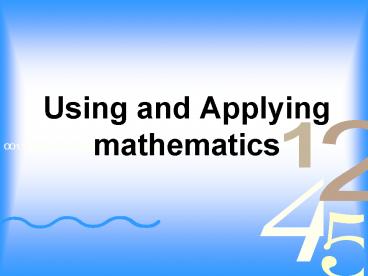Using and Applying mathematics PowerPoint PPT Presentation
1 / 13
Title: Using and Applying mathematics
1
Using and Applying mathematics
2
Aims
- To consider the different elements of the Using
and Applying strand - To understand the progression within each of the
elements - To know the 5 different types of problem
- To understand the range of strategies needed to
solve problems
3
Quick and easy Using and Applying examples.
- Jemma thinks of a number. She says,
- 'Add 3 to my number and then multiply the
result by 5. The answer is 35'. - What is Jemma's number?
- I multiply two numbers and the answer is 48
- Odd one out 1 4 19 25
- Odd one out square, rectangle, equilateral
triangle, trapezium - Can you join all 9 dots using only four straight
lines (you must not take your pencil off the
page)? -
-
-
4
- Using and applying mathematics in the electronic
Framework - One of the aims of the Primary Framework is to
give greater attention to using and applying
mathematics. The Using and applying mathematics
strand has five themes and there is progression
built into each theme. - The five themes are
- Solving problems
- Representing analyse, record, do, check,
confirm - Enquiring plan, decide, organise, interpret,
reason, justify - Reasoning create, deduce, apply, explore,
predict, hypothesise, - test
- Communicating explain methods and solutions,
choices, - decisions,
reasoning
5
Solving problems
6
Possible barriers for children when problem
solving could be
- Unfamiliarity with this type of problem
- Relying on trial and error and hit-and-miss
strategies - Thinking that there was only one solution
- Not reading the problem carefully enough
- Not recording carefully enough the data they
generated - Not talking about the problem with other
children - Not annotating the problem sheet
- Not being secure enough with the strategies.
7
Types of problems.
- Word problems
- Finding all possibilities
- Logic puzzles
- Finding rules and describing patterns
- Diagram problems and visual puzzles
8
Word Problems
- Choose and do a calculation
- Use the result of the calculation to answer the
problem
9
Finding all possibilities
- Systematic generating lists and
organising/recording data - Need to sort the information
- No calculations identified in the problem
- More than one answer
10
Logic puzzles
- No calculations involved
- Given just enough information to solve
- The challenge is to hold one piece of information
while interpreting another
11
Finding rules and describing patterns
- Develops reasoning skills
- Children may develop strategies as they progress
- Children may not find the most efficient way
12
Diagram problems and visual puzzles
- Important to be systematic
- Develops a range of ways of recording
13
Do you provide equal teaching and learning
opportunities for each of the five elements of
the Using and Applying strand and for each of the
five different types of word problems?

